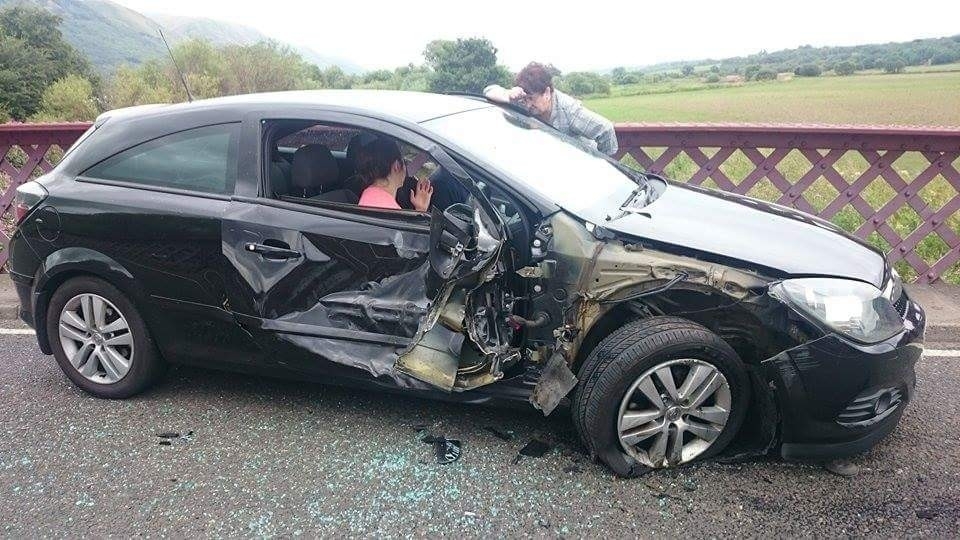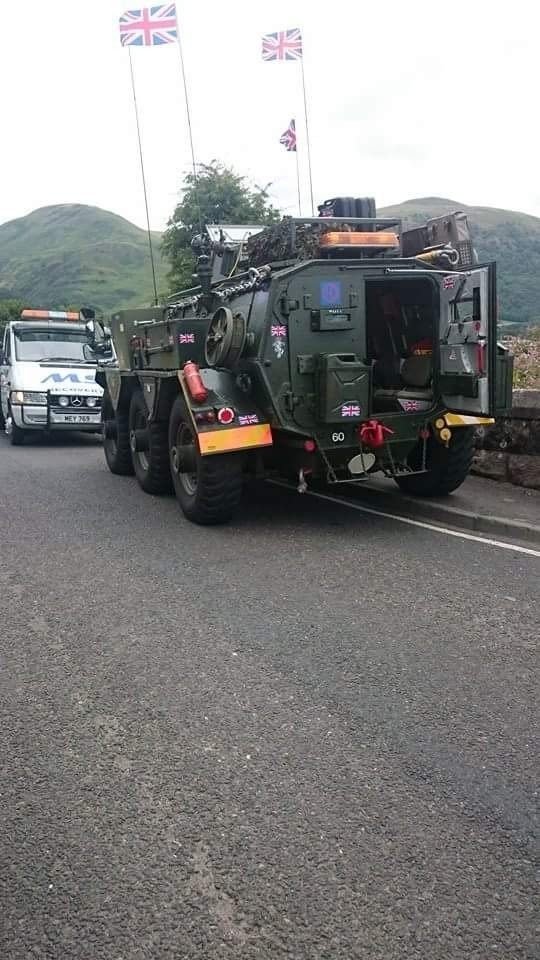A former corporal in the TA who wrote off a Vauxhall Astra after colliding with it in an ex-Army “tank” was spared disqualification today after a sheriff said he was too old to be banned.
Self-employed plumber Robert Shepherd – who was peering through a hatch in the front of his 1954 Alvis Saracen armoured while a pal in the turret acted as “tank commander” – allowed the 11-tonne, Rolls Royce-engined, triple-axled, six-wheeler to veer onto the wrong side the road on a narrow bridge.
The error, as Shepherd, 68, was bringing the Saracen home from a charity gala, meant there was not enough room for oncoming traffic.
The APC’s wheel arch stuck Amanda Ryan’s Vauxhall, as the mother-of-two was trying to cross the bridge over the River Devon near Alva, Clackmannanshire, on her way from her mum’s to her boyfriend’s.
Miss Ryan, 28, was showered with glass, had to freed by firemen, and was taken to hospital with back injuries and later suffered a miscarriage.
Sheriff Eric Brown, who fined Shepherd £270 and added three points to his licence on which there were already nine but did not ban him, was not told of Miss Ryan’s injuries or the miscarriage.
Miss Ryan, who suffered muscle damage and expects to need painkillers for the rest of her life, said the decision was “a travesty”.
She said after the case: “I genuinely thought I was going to die and it’s absurd he can just carry on.”
Her car was later written off by insurers, while the Saracen was only slightly damaged.
Alloa Sheriff Court was told this was due to the “disproportionate size and structure” of the two vehicles.
The incident occurred on the B908 [check] near Alva, Clackmannanhire on a Saturday afternoon last August (2015) at about 4.20pm.
Shepherd was driving while a pal acting as “commander” kept watch out of the turret.
“Overhanging foliage” obscured the view of the “commander”, who therefore did not warn Shepherd about Amanda’s Astra.
Prosecutor Adrian Fraser said: “The APC encroached onto the opposing carriageway, and as a result there was a collision between both vehicles.”
Mr Fraser said the bridge carried a 7.5 tonne weight limit – though Shepherd was not charged with exceeding this limit.
The depute fiscal said: “The position adopted by the accused’s vehicle was such that there was not room for the two vehicles to pass.
“The Astra was hit by the wheel arch of the APC, which juts out.”
Shepherd, of Tullibody, Clackmannanshire, had been due to face trial
today charged with dangerous driving, which he denied, but the prosecution accepted his plea of guilty to the lesser charge of careless driving.
Defence solicitor Jim Savage said there were “quite sharp bends” on the approach to the bridge, and Shepherd never exceeded 25 miles per hour.
He said: “The way this vehicle is driven is that the driver has a restricted view through a hatch, and there was a vehicle commander, in effect, on the top.”His role is to be the eyes of the vehicle.
“He will, as the vehicle approaches difficult obstacles, indicate if the road is clear.
“The driver did receive an indication that the bridge was clear as he approached.
“He did encroach onto the other carriageway.
“In part that is due to the fact that the vehicle is wide.
“The problem was that as they approached the bridge there was heavy foliage on the trees, so the commander of the vehicle wasn’t able to forewarn my client of the Vauxhall approaching from the north.”
Mr Savage added that the APC was fitted with “flying aerials” and flags, which had the specific purpose of drawing attention to the vehicle.
Sheriff Brown said he was “familiar with the vehicle in the general sense, hadn’t driven one personally”.
The lawyer said that any disqualification would be “devastating” for Shepherd, who would have to sack his sole employee.
He added that Shepherd’s “voluntary work, taking his APC round the Galas” would also be lost.
Imposing the fine and points, Sheriff Brown said: “You are 68 and I accept that disqualification would be very significant for some at that stage of your career.
“I also take into account the impact it would have on your employee.
“I am satisfied that the circumstances are such that I can properly exercise my discretion in deciding not to disqualify you on a totting-up basis.”
Shepherd, who said earlier this year that he had once been a corporal in the TA, was a member of a military association, had bought the Saracen in North Wales, and did “a lot of work with the Boy Scouts, and the Army too” with the vehicle, refused to comment on the outcome of the case.
Amanda said outside court that she was shocked that Shepherd would still be able to drive his “tank”.
She said: “My driver’s window was smashed, I got shards of glass in my arms and my back.
“A policeman climbed in the back of my car through the passenger door and braced my neck until the paramedics and the firemen came and got me out.
“I was taken to hospital with back injuries, and I had a miscarriage.
“When I saw that thing coming towards me I thought I was going to die.
” I knew I was on a bridge and I thought I was going to end up in the water.”
Amanda, an information assistant, added: “I used to be a police cadet, and I knew that the charge would get dropped from dangerous to careless, but he already had nine points for driving offences — after what happened to me, not to ban him is ridiculous. It’s a travesty.”
Saracen APCs played a key role in the policing of the “Troubles” in Northern Ireland, and their familiar profile was seen nightly on the nation’s TV screens.
Nicknamed the “sixer”, the Saracen could carry a squad of eight soldiers plus a troop commander could be carried. Most models sported a small turret on the roof, carrying a Browning .30 machine gun.
A .303 Bren gun could be mounted on an anti-aircraft ring-mount accessed through a roof hatch and there were ports on the sides through which troops could fire.built in 1952 for the Malayan Emergency, they have a top speed of 45 miles per hour.


